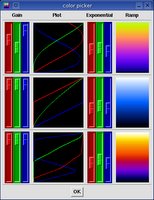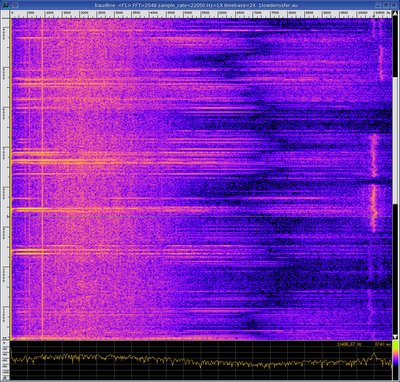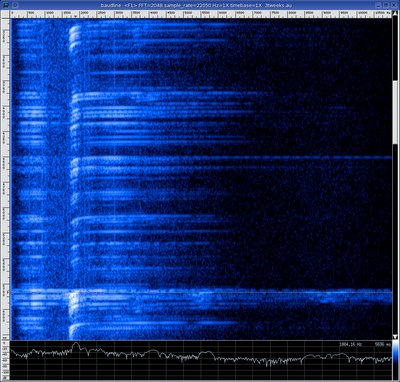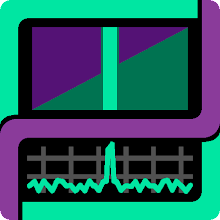The
baudline VLF analyzer was used to investigate some natural radio emission signal files on the NASA INSPIRE VLF project web page:
http://image.gsfc.nasa.gov/poetry/inspire/basic.html
The NASA INSPIRE page has audio samples of sferic, tweek, and whistler signals. The sample rate for all of the .au format files is 22050 for an effective Nyquist bandwidth of 11025 Hz.

Fine adjustment of baudline's Color Aperture, Color Picker, and Windowing controls were performed in order to extract the maximum amount of detail from the VLF signal files. The sferic, tweek, and whistler signals used three different color palettes. See the Color Picker window on the right for the respective RGB curves and spectrogram color ramps.
Sferics
Sferics are caused by lightning and they have spectrums that consist of wideband spectral pulses (horizontal lines). Like a spark gap transmitter, they have infinite bandwidth but the analog capture hardware, digital sampling rate, and atmospheric conduction channel limit this.

The above spectrogram is the low density sferics data file and it has a number of interesting signal features:
- Multiple sferic lightning pulses stretch from 30 Hz to the Nyquist frequency of 11025 Hz.
- A wandering null at around 7000 Hz.
- A strong tone at 926 Hz throughout the entire file.
- Four weaker tones at 184, 308, 432, 556 Hz look like harmonics but they have a delta spacing of 124 Hz. These solid tones are likely artifacts from the capture hardware.
- High frequency wandering tones at 10500 Hz.

The above spectrogram is the dense sferics data and it is very similar to the previous sferics data file but it has some interesting feature differences. The sferics have a much higher density, the strong tones below 1000 Hz are gone, and the wandering null is a little lower at 6000 Hz. New is a decreasing bass chirp that is exponential from 100 to 20 Hz. I'm not sure if this bass chirp is real or if it is an artifact of the collection hardware.
Tweeks
Tweeks are sferics that travel a long distance through the upper atmosphere. Since velocity is a function of wavelength, higher frequencies travel faster than lower frequencies. This phenomena is called dispersion and it manifests itself in the spectrogram as a bending of the straight wideband spectral pulse of the sferic.

The spectral "hooks" between 1700 and 1900 Hz are caused by dispersion. Between 250 to 1000 Hz is an interesting flat spectral region that looks like it is unaffected by dispersion. There are also a number of constant tones but at different frequencies in the sferic's spectrogram. These constants tones are likely collection artifacts or RFI.
Whistlers
A whistler is essentially a sferic that has traveled an even longer distance than a tweek. Usually a whistler is sent out into space and is curved back to earth along magnetic field lines. This longer distance allows for even more dispersion than what a tweek experiences. More distance means more dispersion which causes more curvature. The original sferics wideband pulse is bent into what looks like an exponential downward sweep. See the spectrogram image below:

In the above spectrogram image note that some sferics are mixed in with the whistlers to create a compound image. The 10500 Hz wandering tone that was seen in the sferic's spectrogram has returned. There also several constant tones but they are at slightly different frequencies than the tones that were visible in the sferic and tweek images. Again, collection artifacts or RFI are likely to blame.
In summary; a whistler is a long distance version of a tweek which is a long distance version of a sferic. The VLF signals all start as lightning and velocity dispersion does the rest.









